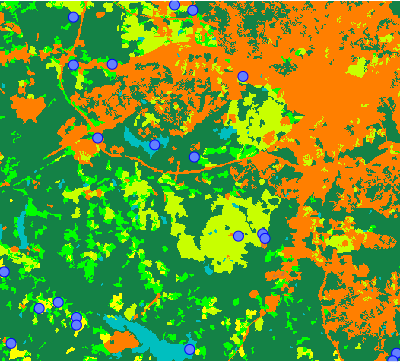
NAME
r.sample.category - Create sampling points from each category in a raster mapKEYWORDS
raster, sampling, random, points, vector, stratified random sampling, categorySYNOPSIS
Flags:
- -s
- If number of cells in category < npoints, skip category
- --overwrite
- Allow output files to overwrite existing files
- --help
- Print usage summary
- --verbose
- Verbose module output
- --quiet
- Quiet module output
- --ui
- Force launching GUI dialog
Parameters:
- input=name [required]
- Name of input raster map with categories (classes)
- output=name [required]
- Name of output vector map with points at random locations
- sampled=name[,name,...]
- Names of input raster maps to be sampled
- npoints=integer[,integer,...] [required]
- Number of sampling points per category in the input map
- You can provide multiple numbers, one for each category in input raster (sorted ascending)
- random_seed=integer
- Seed for random number generator
Table of contents
DESCRIPTION
r.sample.category generates points at random locations. Each category (class) in a raster map will contain specified number of random points.
Different number of points can be specified for different categories. For example, if there are categories 1, 4, 7 in the input raster map, and npoints=100,200,300, 100 points will be generated in category 1, 200 points in category 4 and 300 points in category 7. If only one number is specified, it will be used for every category.
NOTES
Mask (r.mask) to create points in areas with each category, thus mask cannot be active when the module is used.Categories are identified based on current computational region.
EXAMPLE
Generate random points
Generate three points at random location for each category (class) in the raster map:g.region raster=landclass96 r.sample.category input=landclass96 output=landclass_points npoints=3
d.rast map=landclass96 d.vect map=landclass_points icon=basic/circle fill_color=aqua color=blue size=10

Figure: Three random points in each category of landclass raster map
Create a table with values sampled from rasters
Create 2 random points per each category (class) in landclass96 raster and sample elevation and geology_30m rasters at these points:r.sample.category input=landclass96 output=landclass_points sampled=elevation,geology_30m npoints=2
v.db.select landclass_points sep=comma
cat,landclass96,elevation,geology_30m 1,1,102.7855,270 2,1,105.78,270 3,2,114.5954,217 4,2,137.4816,921 5,3,71.19167,270 6,3,93.33904,270 7,4,76.41077,262 8,4,97.54424,217 9,5,138.455,405 10,5,88.8075,270 11,6,126.5298,217 12,6,86.73177,217 13,7,134.5381,217 14,7,99.6844,270
SEE ALSO
v.sample, r.random, r.random.cells, v.random, v.what.rast, r.describeAUTHORS
Vaclav Petras, NCSU OSGeoREL,Anna Petrasova, NCSU OSGeoREL
SOURCE CODE
Available at: r.sample.category source code (history)
Latest change: Thursday Mar 20 21:36:57 2025 in commit: 7286ecf7af235bfd089fb9b1b82fb383cf95f3fc
Main index | Raster index | Topics index | Keywords index | Graphical index | Full index
© 2003-2025 GRASS Development Team, GRASS GIS 8.4.3dev Reference Manual